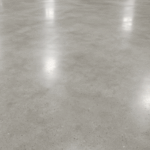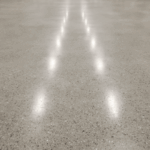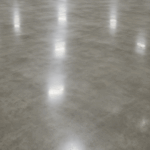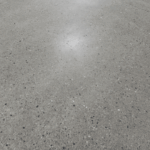Insulation fill
- Home
- Insulation fill
Insulation fill & blow-in insulation: Efficient insulation for cavities & ceilings
Not all areas of a building can simply be insulated with insulation boards or mats. Loose insulation materials really come into their own in cavities, irregular structures or areas that are difficult to access. Insulation fill and blow-in insulation are highly efficient methods for creating a gapless, thermal bridge-free insulation layer. Whether insulating the top storey ceiling, wooden beam ceilings or retrofitting core insulation to double-shell masonry, these techniques often offer a quick and economical solution. As your experienced specialists for insulation technology and floor structures, operating throughout Germany, we will advise you on the most suitable materials and ensure that they are professionally installed.
What are bulk & blow-in insulation materials?
In contrast to dimensionally stable boards, these are loose insulation materials in the form of:
- Flakes (e.g. cellulose insulation, wood fiber blow-in insulation)
- Granulates (e.g. mineral wool granulate, EPS granulate, perlite)
- Beads (e.g. EPS)
These materials are either poured loose or blown in by machine.
The processes: Pouring vs. blowing in
- Insulation fill (loose fill insulation):
- Application: Mainly on open, horizontal surfaces, such as the top storey ceiling between the ceiling joists or in unused cavities. Keyword: Attic insulation fill.
- Procedure: The material is poured onto the surface from bags and evenly distributed and leveled to the desired height. Relatively simple processing.
- Blow-in insulation:
- Application: For closed or difficult to access cavities such as sloping roofs, wooden beam ceilings, installation shafts or double-shell masonry (core insulation).
- Procedure: The loose insulation material is transported into the cavity under air pressure via hoses using a special blowing machine. There, the material compacts and fills the space completely.
- Advantage: Enables insulation without large openings in the structure, ensures controlled density and resistance to settlement.
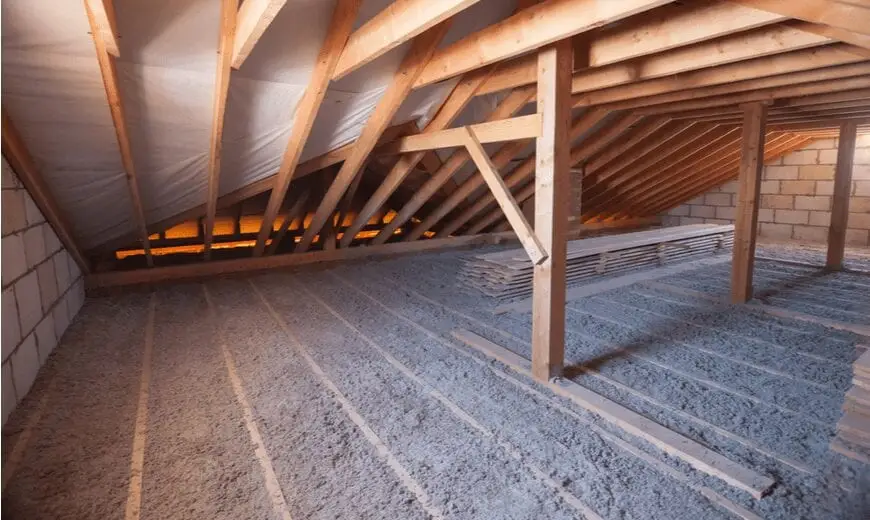
Advantages & areas of application of loose insulation
These insulation methods offer specific advantages:
- Seamless insulation: The material adapts perfectly to any shape, encloses rafters, beams or pipes without joints and minimizes thermal bridges in the insulated area. Ideal for cavity insulation.
- Efficient for inaccessible areas: Blow-in insulation in particular makes it possible to retrofit insulation to hard-to-reach components.
- Fast processing: Large areas (e.g. top floor ceiling) or cavities can often be insulated very quickly.
- Versatile materials: Various ecological (cellulose, wood fiber) and mineral (rock/glass wool) or synthetic (EPS) options are available.
- Cost-effectiveness: Often a very cost-effective insulation measure, especially when insulating the top storey ceiling or core insulation.
Focus on materials: cellulose, wood fiber, mineral wool
The most common bulk and blow-in insulation materials:
- Cellulose insulation: Made from recycled newsprint. Ecological, good thermal and summer heat insulation, moisture-regulating. Mainly used as blow-in insulation.
- Wood fiber blow-in insulation: Made from loose wood fibers. Similar advantages to cellulose, very good heat protection.
- Mineral wool (rock/glass wool as granules/flakes): Non-combustible (A1), good sound insulation, insensitive to moisture and pests. As fill or blown-in insulation.
- EPS granules: Lightweight polystyrene beads, water-repellent. Often used for core insulation (with binder) or as leveling fill.
- Perlite/vermiculite: Mineral granules, non-combustible, very light, but less insulating than the other materials.
The choice depends on the area of application, the fire, sound and moisture protection requirements and ecological preferences.
Decisive for quality: density, preparation & execution
For permanently effective insulation, it's all about the details:
- Installation density (for blow-in insulation): Absolutely critical! Only if the material is blown in at the density specified by the manufacturer is the full insulating effect and, above all, settlement resistance guaranteed. Material that is blown in too loosely will later sag! This requires special blowing machines and trained personnel. We carry out a density check!
- Substrate/cavity condition: The area must be clean and dry. In the case of diffusion-open insulation materials, an airtight membrane/vapor barrier may be required on the warm side (planning!).
- Professional placement: Even distribution, complete backfilling of all areas.
Costs for fill & blow-in insulation
These insulation methods are often very economical. The costs depend on the chosen material, the required quantity (insulation thickness or volume of the cavity) and the effort required for installation (pouring is easier, blowing in requires machine technology). The blow-in insulation costs for core insulation or loft insulation in particular are often quickly amortized by the energy savings. An individual offer is necessary.
Your nationwide partner for fill & blow-in insulation
We offer you:
- Expert advice on choosing the right insulation material and process.
- Professional execution of loose-fill and blow-in insulation with modern technology.
- Controlled installation density for guaranteed settlement resistance with blow-in insulation.
- Reliable service for your insulation project - nationwide.
Conclusion: Loose insulation materials - efficient solution for many insulation tasks
Insulation fills and blow-in insulation are intelligent methods for insulating cavities and top storey ceilings in particular in a seamless, efficient and often cost-effective manner. The choice of the right material and, above all, professional execution - especially maintaining the correct installation density for blow-in insulation - are crucial for long-term success.
Insulate cavities efficiently? We are your partner!
Would you like to retrofit insulation to your top storey ceiling, roof or walls (core insulation)? Contact us for advice on loose-fill and blow-in insulation and a quote for your project anywhere in Germany. We are there for you by phone, email or WhatsApp.
Frequently asked questions (FAQ)
Bulk insulation is loosely applied and distributed on open, usually horizontal surfaces. Blow-in insulation is mechanically blown into closed or difficult to access cavities under air pressure and compacted in a controlled manner.
Yes, if it is carried out professionally! It is crucial that the material is blown in with the minimum installation density specified by the manufacturer. A qualified specialist company will check and document this. This prevents subsequent sagging.
Loose insulation fills or blown-in insulation (e.g. made of cellulose, mineral wool, wood fiber) are often ideal here, as they adapt perfectly to beam layers and form a gapless insulation layer. Installation is usually very quick.
Yes, blow-in insulation (often with hydrophobic EPS granulate or mineral wool granulate) is the standard method for efficiently insulating the air gap of a double-skin masonry structure retrospectively and without major intervention.
No, on the contrary. Compared to other insulation measures, it is often very economical, as the materials are sometimes inexpensive (e.g. cellulose from recycling) and processing (especially blowing in) can be carried out very quickly. The costs are usually quickly amortized through the energy savings.
